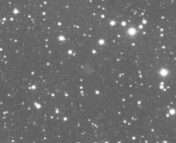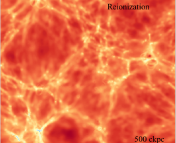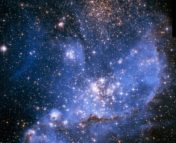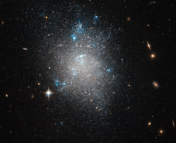Title: Reionization of the Milky Way, M31, and their satellites I: Reionization History and Star Formation
Authors: K. L. Dixon, I. T. Iliev, S. Gottlober, G. Yepes, A. Knebe, N. Libeskind, Y. Hoffman
First Author’s Institution: Astronomy Centre, Department of Physics & Astronomy, University of Sussex, Falmer, Brighton, UK
Status: Submitted to MNRAS, open access
There was a time in the universe when there were no stars. It was only after a long, dark 100 million years or so that the first stars—giant, blindingly bright monoliths a species apart from today’s stars—blinked on. As these stars blazed to life, they unleashed vast amounts of energetic ultraviolet (UV) photons. The universe at that time was filled mostly with cold hydrogen gas—cold enough to be in neutral form, single atoms of hydrogen. The UV photons unleashed by the stars changed this—they heated up the hydrogen gas and broke the atoms up into bare protons and electrons. This process was so efficient that the entire universe was reionized.
In what seems like a cosmic fluke, it appears that much of the UV photons may have come from small galaxies—those at least a thousand times less massive than the Milky Way, which we call “dwarf” galaxies. For despite their diminutive size, there were legions of them—easily a hundred, if not a thousand dwarfs for each Milky Way-mass galaxy. Thus although each dwarf produced far less UV than a larger, Milky Way type galaxy, their sheer numbers caused them to produce more UV combined than larger galaxies. Their prodigious UV output also ushered in their fall—reionization seems to have slowed or even halted star formation in dwarfs, possibly by heating up or even evaporating all the star-forming, cold gas within them.
Our own galactic neighborhood, also called the Local Group—the corner of the universe with our home galaxy, the Milky Way and our sister the Andromeda Galaxy (also known more arcanely as as M31), hosts dozens of dwarf galaxies that should have undergone precisely this. Thus the Local Group is a potentially illuminating place to look for clues as to how reionization affected star formation in dwarfs. But it’s not entirely clear what to search for. Would reionization produce dwarfs that completely stopped forming stars during reionization? Or those that only gradually kept forming stars? Should we expect stars in only the most massive dwarfs? We’re not sure.
To rescue us from this quandary are the authors of today’s paper. They took a simulation of the Local Group and an adjacent group of galaxies, the nearby Virgo Cluster, and modeled how reionization may have taken place. To take into account the fact that we don’t know how much stars and UV the dwarf galaxies produced, they ran their simulation four times, identical except for how much ionizing UV the dwarfs contributed. In the first, the dwarfs contributed nothing at all—only the largest galaxies produced stars and reionizing UV. In the second, dwarfs contributed only if they were fairly isolated, far from larger galaxies. In the third, the dwarfs also contributed when close to a larger galaxy, although with reduced output. The last simulation was identical to the third, except that the amount a dwarf’s UV output was reduced depended on its mass—more massive dwarfs were more efficient at generating UV than lower mass dwarfs.
What did they find? How early you reionized depends on how dense your corner of the universe is—Virgo, the most dense region between itself, the Milky Way, and M31, reionized first, and then was followed by M31, and then the the Milky Way, the least dense of them all. In addition, in all cases in which dwarfs contributed, Virgo, M31, and the Milky Way appeared to reionize mostly “inside out”—the galaxies within reionized themselves, and then their surroundings. Once reionization got underway in the Local Group, it quickly progressed (faster than the rest of the universe), but slowed when about half the gas was ionized. The rest of the gas was reionized externally: it picked up again when an ionizing front from outside the Group swept through (see Figure 1).

Figure 1. Ionization of our galactic neighborhood. The time axis, measured in redshift, is backward (i.e. time starts at high redshift, on the right, and then progresses to lower redshift, towards the left). Each panel shows one of the four simulations run in this paper (see preceding paragraph). On the lower panels is the fraction of the hydrogen gas ionized over time for each sim. You can see the Virgo Cluster, shown in purple, reionized first, followed by the Local Group, shown in blue. The average fraction in the entire universe is shown in black. The top panels show how quickly Virgo or the Local Group reionized compared to the universe. When they first reionize, the rates are negative—they reionize faster than the universe, likely because the galaxies within Virgo and the Local Group are ionizing themselves quickly. The rate eventually becomes positive—reionization slows down. In the Local Group, it then picks back up at the end of reionization (at z~6), as outside sources ionize the rest of the gas. Figure taken from today’s paper.
For the dwarfs, the authors found that the most massive ones generally reionized first, and that most satellites in the Local Group were ionized around the same time. But it appears difficult to determine when a Milky Way dwarf was ionized based on where it is today. In general, those that are closer to the Milky Way today appear to have formed most of their stars before reionization. Only about 20% of the dwarfs were able to form stars before reionization was complete—given that we see many low mass dwarfs that appear to have formed stars after reionization, this rules out scenarios in which dwarfs did not produce UV (and thus stars) after they came in close proximity to the Milky Way.
It’s clear that reionization was complex, that and a particular dwarf’s ability to form stars is dependent on details about its environment during reionization. Simulations that model this era of cosmic history in more detail (such as reionization due to supernovae) will help us better understand the role that dwarfs played in reionization, and how they were affected by it.
Cover image: Figure from today’s paper that shows how early the gas in the galactic neighborhood was reionized. Note that Virgo is brighter than the Local Group, indicating that the Virgo Cluster was reionized first.





Trackbacks/Pingbacks